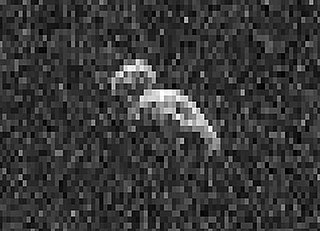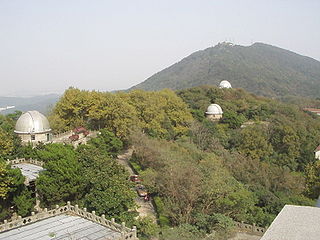Related Research Articles

A near-Earth object (NEO) is any small Solar System body whose orbit around the Sun can bring it near the Earth. By convention, a small natural Solar System body is a NEO if its closest approach to the Sun (perihelion) is less than 1.3 astronomical units (AU). If a NEO's orbit crosses the Earth's orbit, and the object is larger than 140 meters (460 ft) across, it is considered a potentially hazardous object (PHO). Most known PHOs and NEOs are asteroids, but about 0.35% are comets.

The Oort cloud, sometimes called the Öpik–Oort cloud, is theorized to be a vast cloud of icy planetesimals surrounding the Sun at distances ranging from 2,000 to 200,000 AU. The concept of such a cloud was proposed in 1950 by the Dutch astronomer Jan Oort, in whose honor the idea was named. Oort proposed that the bodies in this cloud replenish and keep constant the number of long-period comets entering the inner Solar System—where they are eventually consumed and destroyed during close approaches to the Sun.

The Solar System is the gravitationally bound system of the Sun and the objects that orbit it. The largest of these objects are the eight planets, which in order from the Sun are four terrestrial planets ; two gas giants ; and two ice giants. The Solar System developed 4.6 billion years ago when a dense region of a molecular cloud collapsed, forming the Sun and a protoplanetary disc.

The following outline is provided as an overview and topical guide to space science:

Astronomy is a natural science that studies celestial objects and the phenomena that occur in the cosmos. It uses mathematics, physics, and chemistry in order to explain their origin and their overall evolution. Objects of interest include planets, moons, stars, nebulae, galaxies, meteoroids, asteroids, and comets. Relevant phenomena include supernova explosions, gamma ray bursts, quasars, blazars, pulsars, and cosmic microwave background radiation. More generally, astronomy studies everything that originates beyond Earth's atmosphere. Cosmology is a branch of astronomy that studies the universe as a whole.

A meteoroid is a small rocky or metallic body in outer space. Meteoroids are distinguished as objects significantly smaller than asteroids, ranging in size from grains to objects up to a meter wide. Objects smaller than meteoroids are classified as micrometeoroids or space dust. Most are fragments from comets or asteroids, whereas others are collision impact debris ejected from bodies such as the Moon or Mars.

Astrochemistry is the study of the abundance and reactions of molecules in the universe, and their interaction with radiation. The discipline is an overlap of astronomy and chemistry. The word "astrochemistry" may be applied to both the Solar System and the interstellar medium. The study of the abundance of elements and isotope ratios in Solar System objects, such as meteorites, is also called cosmochemistry, while the study of interstellar atoms and molecules and their interaction with radiation is sometimes called molecular astrophysics. The formation, atomic and chemical composition, evolution and fate of molecular gas clouds is of special interest, because it is from these clouds that solar systems form.

Outer space is the expanse beyond celestial bodies and their atmospheres. Outer space is not completely empty; it is a near-perfect vacuum containing a low density of particles, predominantly a plasma of hydrogen and helium as well as electromagnetic radiation, magnetic fields, neutrinos, dust, and cosmic rays. The baseline temperature of outer space, as set by the background radiation from the Big Bang, is 2.7 kelvins.

Planetesimals are solid objects thought to exist in protoplanetary disks and debris disks. Per the Chamberlin–Moulton planetesimal hypothesis, they are believed to form out of cosmic dust grains. Believed to have formed in the Solar System about 4.6 billion years ago, they aid study of its formation.

The Purple Mountain Observatory, also known as Zijinshan Astronomical Observatory is an astronomical observatory located on the Purple Mountain in the east of Nanjing.

The following outline is provided as an overview of and topical guide to astronomy:

Abraham "Avi" Loeb is an Israeli-American theoretical physicist who works on astrophysics and cosmology. Loeb is the Frank B. Baird Jr. Professor of Science at Harvard University, where since 2007 he has been Director of the Institute for Theory and Computation at the Center for Astrophysics. He chaired the Department of Astronomy from 2011–2020, and founded the Black Hole Initiative in 2016.

An interstellar object is an astronomical object in interstellar space that is not gravitationally bound to a star. This term can also be applied to an object that is on an interstellar trajectory but is temporarily passing close to a star, such as certain asteroids and comets. In the latter case, the object may be called an interstellar interloper.

Technosignature or technomarker is any measurable property or effect that provides scientific evidence of past or present technology. Technosignatures are analogous to biosignatures, which signal the presence of life, whether intelligent or not. Some authors prefer to exclude radio transmissions from the definition, but such restrictive usage is not widespread. Jill Tarter has proposed that the search for extraterrestrial intelligence (SETI) be renamed "the search for technosignatures". Various types of technosignatures, such as radiation leakage from megascale astroengineering installations such as Dyson spheres, the light from an extraterrestrial ecumenopolis, or Shkadov thrusters with the power to alter the orbits of stars around the Galactic Center, may be detectable with hypertelescopes. Some examples of technosignatures are described in Paul Davies's 2010 book The Eerie Silence, although the terms "technosignature" and "technomarker" do not appear in the book.

ʻOumuamua is the first interstellar object detected passing through the Solar System. Formally designated 1I/2017 U1, it was discovered by Robert Weryk using the Pan-STARRS telescope at Haleakalā Observatory, Hawaii, on 19 October 2017, approximately 40 days after it passed its closest point to the Sun on 9 September. When it was first observed, it was about 33 million km from Earth and already heading away from the Sun.

2I/Borisov, originally designated C/2019 Q4 (Borisov), is the first observed rogue comet and the second observed interstellar interloper after ʻOumuamua. It was discovered by the Crimean amateur astronomer and telescope maker Gennadiy Borisov on 29 August 2019 UTC.
CNEOS 2014-01-08, is a putative interstellar object reported in June 2019 by astronomers Amir Siraj and Abraham Loeb, and confirmed by the United States Space Command in April 2022. The discovery was publicized in 2019 in a preprint announcing a 0.45 m (1.5 ft) meteor detected on 8 January 2014 near the northeast coast of Papua New Guinea.
The Galileo Project is an international scientific research project to systematically search for extraterrestrial intelligence or extraterrestrial technology on and near Earth and to identify the nature of anomalous Unidentified Flying Objects/Unidentified Aerial Phenomena (UFOs/UAP).
References
- 1 2 "17-year-old Brookline boy wins Presidential Scholar in the Arts award". Boston 25 News. 11 May 2017. Retrieved 31 August 2023.
- ↑ "This Land/Our Land: A interview with 17-year-old pianist Amir Siraj". From The Top. 2 July 2017. Retrieved 17 January 2023.
- ↑ "Research Team" . Retrieved 31 August 2023.
- 1 2 "Forbes 30 Under 30 2021: Science". Forbes. Retrieved 2024-01-18.
- ↑ "Amir Siraj". Forbes. Retrieved 2024-01-18.
- ↑ "Amir Siraj". Department of Astrophysical Sciences. Retrieved 2024-01-18.
- ↑ O'Kane, Caitlin (2022-04-15). "U.S. Space Command confirms interstellar meteor hit Earth - CBS News". www.cbsnews.com. Retrieved 2024-01-17.
- ↑ Tomaswick, Andy (2022-11-11). "We'll Inevitably see Another Interstellar Object. Which Ones Make the Best Targets to Visit?". Universe Today. Retrieved 2024-01-17.
- ↑ Karlis, Nicole (2021-02-17). "Why some scientists think a comet, not an asteroid, caused the dinosaurs to go extinct". Salon. Retrieved 2024-01-17.
- ↑ Kramer, Miriam (August 24, 2021). "Interstellar objects are everywhere". Axios . Retrieved January 17, 2024.
- ↑ "Did the Sun have a twin? New study rewrites the star's early history". Inverse. 2020-08-20. Retrieved 2024-01-17.
- ↑ Gough, Evan (2021-09-09). "Protoplanetary Disks Throw Out More Material Than Gets Turned Into Planets". Universe Today. Retrieved 2024-01-18.
- ↑ Wood, Charlie (2020-04-30). "Ancient supernovas may have pierced moon rocks with star shrapnel". Popular Science. Retrieved 2024-01-17.
- ↑ Carter, Jamie. "Is 'Planet Nine' Actually A Black Hole In The Solar System? There's Only One Way To Find Out". Forbes. Retrieved 2024-01-17.
- ↑ Overbye, Dennis (2020-09-11). "Is There a Black Hole in Our Backyard?". The New York Times. ISSN 0362-4331 . Retrieved 2024-01-17.
- ↑ Tillman, Nola Taylor (2020-01-22). "Interstellar Visitors Could Export Terrestrial Life to Other Stars". Eos. Retrieved 2024-01-17.
- ↑ Ferreira, Becky. "Stolen planet could be hiding on the edge of our solar system". New Scientist. Retrieved 2024-01-17.
- ↑ Tognetti, Laurence (2023-12-31). "How Many Planets Could Be in the Kuiper Belt?". Universe Today. Retrieved 2024-01-17.
- ↑ Starr, Michelle (2024-01-10). "There Could Be Alien, Mars-Sized Planets Lurking Beyond Pluto". ScienceAlert. Retrieved 2024-01-17.
- ↑ Jain, Deepa (2024-01-16). "5 Earth-like worlds may lurk in the outer reaches of the solar system, simulations suggest". livescience.com. Retrieved 2024-01-17.
- ↑ Siraj, Amir; Loeb, Abraham (2022). "A Meteor of Apparent Interstellar Origin in the CNEOS Fireball Catalog". The Astrophysical Journal. 939 (1): 53. Bibcode:2022ApJ...939...53S. doi: 10.3847/1538-4357/ac8eac .
- 1 2 Pultarova, Tereza (3 November 2022). "Confirmed! A 2014 meteor is Earth's 1st known interstellar visitor - Interstellar space rocks might be falling to Earth every 10 years". Space.com . Retrieved 4 November 2022.
- ↑ Roulette, Joey (2022-04-15). "Military Memo Deepens Possible Interstellar Meteor Mystery". The New York Times. ISSN 0362-4331 . Retrieved 2024-01-17.
- ↑ Wattles, Ashley Strickland,Jackie (2022-12-27). "2022's extraordinary cosmic revelations and moments in space exploration". CNN. Retrieved 2024-01-18.
{{cite web}}: CS1 maint: multiple names: authors list (link) - ↑ Lucchesi, Emilie Le Beau (2022-11-03). "Rising star in astronomy: Amir Siraj". Astronomy Magazine. Retrieved 2024-01-18.
- ↑ "Stories by Amir Siraj". Scientific American. Retrieved 2024-01-18.
- ↑ "On music and the universe: Advice from a Cliburn Junior alum - and now, an astrophysicist". KERA News. 2023-05-15. Retrieved 2024-01-18.
- ↑ "Soundboard — Amir Siraj - Steinway & Sons". www.steinway.com. Retrieved 2024-01-17.
- ↑ "Recital: Amir Siraj '23 MM, Piano | New England Conservatory". necmusic.edu. 2023-05-12. Retrieved 2024-01-18.
- ↑ "Creating the Future: Amir Siraj '23 MM Performs with Yo-Yo Ma and Emanuel Ax in Paris | New England Conservatory". necmusic.edu. 2022-10-26. Retrieved 2024-01-17.
- ↑ "UNESCO welcomes the acclaimed cellist Yo-Yo Ma". December 8, 2022. Retrieved January 17, 2024.
- ↑ "The Halftime Show: Song, stories, and solutions | UN Office for Partnerships". unpartnerships.un.org. Retrieved 2024-01-18.
- ↑ Gordon, Amanda (21 September 2017). "SoftBank CEO Parties With Smart Robots During UN GA Week". Bloomberg. Retrieved 2024-01-18.
- ↑ "Amir Siraj performs on stage during the 60th Annual GRAMMY Awards -..." Getty Images. 27 January 2018. Retrieved 2024-01-18.
- ↑ Prejean, Jeanne (2019-01-10). "JUST IN: The Cliburn International Junior Piano Competition And Festival Is Coming To Dallas And Tickets Just Went On Sale". My Sweet Charity. Retrieved 2024-01-18.
- ↑ "Media & Press". Swiss Alps Classics. Retrieved 2024-01-18.
- ↑ "Aspen Center for Physics: physicists Lisa Randall and Vijay Balasubramanian in conversation with composer Chris Theofanidis and John Luther Adams on music, science & creativity". Aspen Public Radio. 2023-08-11. Retrieved 2024-01-18.
- ↑ "The Musical Inspiration of National Parks". National Park Foundation. Retrieved January 17, 2024.
- ↑ MacCurtain, Erin (2020-08-05). "Alumni Leadership Grant Spotlight: Music for the Parks". From the Top. Retrieved 2024-01-18.